Extracellular Vesicle-Serpine-1 Affects Neural Progenitor Cell Mitochondrial Networks and Synaptic Density: Modulation by Amyloid Beta and HIV-1
- PMID: 37458985
- PMCID: PMC10533645
- DOI: 10.1007/s12035-023-03456-y
Extracellular Vesicle-Serpine-1 Affects Neural Progenitor Cell Mitochondrial Networks and Synaptic Density: Modulation by Amyloid Beta and HIV-1
Abstract
Brain endothelial extracellular vesicles carrying amyloid beta (EV-Aβ) can be transferred to neural progenitor cells (NPCs) leading to NPC dysfunction. However, the events involved in this EV-mediated Aβ pathology are unclear. EV-proteomics studies identified Serpine-1 (plasminogen activator inhibitor 1, PAI-1) as a major connecting "hub" on several protein-protein interaction maps. Serpine-1 was described as a key player in Aβ pathology and was linked to HIV-1 infection as well. Therefore, the aim of this work was to address the hypothesis that Serpine-1 can be transferred via EVs from brain endothelial cells (HBMEC) to NPCs and contribute to NPC dysfunction. HBMEC concentrated and released Serpine-1 via EVs, the effect that was potentiated by HIV-1 and Aβ. EVs loaded with Serpine-1 were readily taken up by NPCs, and HIV-1 enhanced this event. Interestingly, a highly specific Serpine-1 inhibitor PAI039 increased EV-Aβ transfer to NPCs in the presence of HIV-1. PAI039 also partially blocked mitochondrial network morphology alterations in the recipient NPCs, which developed mainly after HIV + Aβ-EV transfer. PAI039 partly attenuated HIV-EV-mediated decreased synaptic protein levels in NPCs, while increased synaptic protein levels in NPC projections. These findings contribute to a better understanding of the complex mechanisms underlying EV-Serpine-1 related Aβ pathology in the context of HIV infection. They are relevant to HIV-1 associated neurocognitive disorders (HAND) in an effort to elucidate the mechanisms of neuropathology in HIV infection.
Keywords: Amyloid beta; Blood–brain barrier; Extracellular vesicles; HIV-1; Neural progenitor cells; Serpine-1.
© 2023. The Author(s).
Conflict of interest statement
The authors declare that they have no competing interests.
Figures
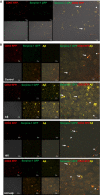



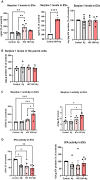
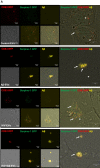



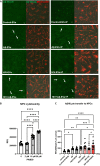
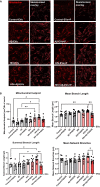
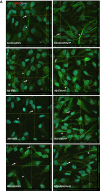

Update of
-
Extracellular vesicle-Serpine-1 affects neural progenitor cell mitochondrial functions and synaptic density: modulation by amyloid beta and HIV-1.Res Sq [Preprint]. 2023 Feb 15:rs.3.rs-2551245. doi: 10.21203/rs.3.rs-2551245/v1. Res Sq. 2023. Update in: Mol Neurobiol. 2023 Nov;60(11):6441-6465. doi: 10.1007/s12035-023-03456-y. PMID: 36824983 Free PMC article. Updated. Preprint.
Similar articles
-
Extracellular vesicle-Serpine-1 affects neural progenitor cell mitochondrial functions and synaptic density: modulation by amyloid beta and HIV-1.Res Sq [Preprint]. 2023 Feb 15:rs.3.rs-2551245. doi: 10.21203/rs.3.rs-2551245/v1. Res Sq. 2023. Update in: Mol Neurobiol. 2023 Nov;60(11):6441-6465. doi: 10.1007/s12035-023-03456-y. PMID: 36824983 Free PMC article. Updated. Preprint.
-
Extracellular vesicle-mediated amyloid transfer to neural progenitor cells: implications for RAGE and HIV infection.Mol Brain. 2020 Feb 17;13(1):21. doi: 10.1186/s13041-020-0562-0. Mol Brain. 2020. PMID: 32066471 Free PMC article.
-
Extracellular vesicles regulate gap junction-mediated intercellular communication and HIV-1 infection of human neural progenitor cells.Neurobiol Dis. 2021 Jul;155:105388. doi: 10.1016/j.nbd.2021.105388. Epub 2021 May 5. Neurobiol Dis. 2021. PMID: 33962010 Free PMC article.
-
Extracellular Vesicles: A Possible Link between HIV and Alzheimer's Disease-Like Pathology in HIV Subjects?Cells. 2019 Aug 24;8(9):968. doi: 10.3390/cells8090968. Cells. 2019. PMID: 31450610 Free PMC article. Review.
-
Emerging Roles of Extracellular Vesicles in Alzheimer's Disease: Focus on Synaptic Dysfunction and Vesicle-Neuron Interaction.Cells. 2022 Dec 23;12(1):63. doi: 10.3390/cells12010063. Cells. 2022. PMID: 36611856 Free PMC article. Review.
Cited by
-
A deep phenotyping study in mouse and iPSC models to understand the role of oligodendroglia in optic neuropathy in Wolfram syndrome.Acta Neuropathol Commun. 2024 Aug 28;12(1):140. doi: 10.1186/s40478-024-01851-7. Acta Neuropathol Commun. 2024. PMID: 39198924 Free PMC article.
-
Bridging brain and blood: a prospective view on neuroimaging-exosome correlations in HIV-associated neurocognitive disorders.Front Neurol. 2025 Jan 7;15:1479272. doi: 10.3389/fneur.2024.1479272. eCollection 2024. Front Neurol. 2025. PMID: 39839878 Free PMC article. Review.
-
Therapy-induced senescent tumor cell-derived extracellular vesicles promote colorectal cancer progression through SERPINE1-mediated NF-κB p65 nuclear translocation.Mol Cancer. 2024 Apr 4;23(1):70. doi: 10.1186/s12943-024-01985-1. Mol Cancer. 2024. PMID: 38576002 Free PMC article.
-
S-Adenosylmethionine Inhibits Plasminogen-Activating Inhibitor-1 and Protects Male Mice From FOLFOX-Induced Liver Injury.Cell Mol Gastroenterol Hepatol. 2025;19(8):101513. doi: 10.1016/j.jcmgh.2025.101513. Epub 2025 Apr 17. Cell Mol Gastroenterol Hepatol. 2025. PMID: 40246076 Free PMC article.
References
MeSH terms
Substances
Grants and funding
LinkOut - more resources
Full Text Sources
Medical
Miscellaneous

